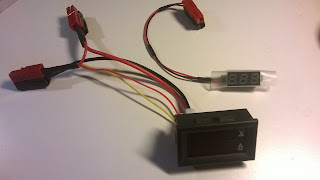 DIY Powerpole voltage and current meters
DIY Powerpole voltage and current meters
Powerpole voltage and current monitoring is quite nice to have. One can buy commercial meters, but due to the availability of nice and cheap modules, it is very easy to make them oneself.
To the right you’ll see my combined voltage and current meter as well as my volt-meter on top of the power supply.
Both of the modules have been bought on Ebay:
- Miniature 0-30 V DC LED 2 wire Digital voltmeter (371333527599) where the display is 22 by 10 mm. Cost slightly more than $1
- 0-100 V, 0-10 A Dual Voltmeter Ammeter (262455987311) costing less than $3. The module size is 48 x 29 x 26 mm and the letters are 7 mm tall just like the miniature voltage display.















Have a similar DC Voltmeter/Ammeter in the shack as well as an AC version for the Generator/Inverter.
Measuring the current in the -ve lead, is OK when the PSU or rig is otherwise isolated, but take care when mobile, as the multiple grounds will bypass the shunt, and give you bad readings.
Portable, powered from a single battery is probably OK.
It’s easy to measure the -ve side (read cheap!) But not difficult to measure current in the +ve side, just needing the appropriate components, and some inginuity.
73.
Dave ‘kbv
You can get the meters in different colors and sizes, but I’m not sure if one can select current metering in the +ve lead as an option. But, thanks for the reminder, it may be important sometimes.